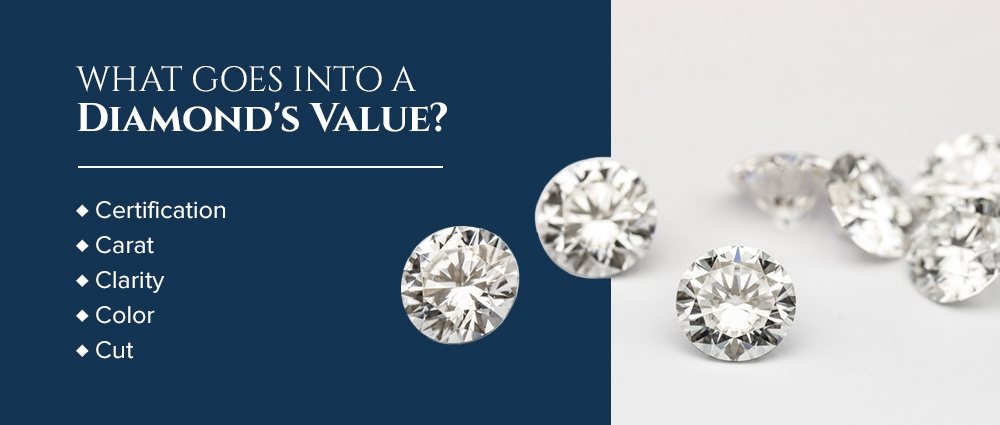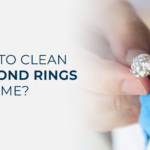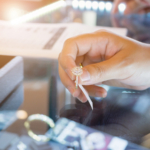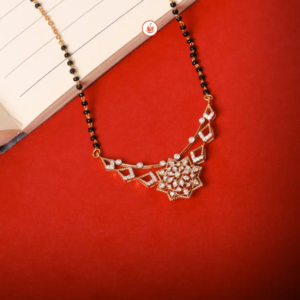What are Diamond Values?
WHAT ARE DIAMOND VALUES?
A diamond’s allure is its beauty and brightness. A diamond is a real investment for many, a picture of months of saving, a perk, and best gemstones.
It is crucial to understand the value of diamonds, though. Is the stone’s worth best reflected by the price listed on the price tag? Four elements, referred to as the “4Cs” in the jewelry business, determine a diamond’s value while buying a diamond:
- Cut
- Color
- Clarity
- Carat
A diamond’s price and worth are influenced by each of these four Cs, and each one has the potential to significantly raise or lower the stone’s value. Due to this, even among stones of the same size or form, the value of diamonds can differ significantly, making it crucial to understand how to purchase a diamond.
Diamond Value in Terms of Cut
A diamond’s cut does not determine the stone’s form. A common misconception is that the cut is the same regardless of the stone’s form, such as round brilliant, princess, pear, or marquise. Although the cut of a diamond is distinct for each shape, it is graded by a certain gem grading laboratory and is referred to as the cut of a diamond.
The grading scheme differs for each lab. These are the cut grades, according to the Gemological Institute of America (GIA):
- Excellent
- Very Good
- Good
- Fair
- Poor
There are several considerations behind these grades. Brightness, fire, scintillation, weight to carat ratio, durability, polish, and symmetry are the seven characteristics of a diamond that the GIA states are important to consider while evaluating cut.
The stone’s beauty is impacted by each of these factors. Brightness is described by the GIA as “the total light reflected from a diamond.” In the stone, light is refracted and reflected by fire and scintillation as well.
The diamond’s weight dispersion is also influenced by its cut. A stone that is cut excessively top heavy or heavier on the bottom is something that no buyer wants, of course.
The aesthetic of a diamond shape can also be impacted by the cut. A marquise may resemble a pear more if it has a bottom-heavy cut.
Also crucial is symmetry. A well-cut diamond ought to be symmetrical and aesthetically beautiful. The way the stone pulls in light or how the line interacts with the stone may both be impacted by an uneven cut.
Diamond Value in Terms of Color
One of the four Cs, color, influences a stone’s worth and price, but one’s perception of a stone’s beauty will depend on how they perceive it to be colored. The letter-by-alphabet grade system for color begins at D. The colorless designation is given to a diamond having a D grade for color.
The value of yellow warmth is represented by each letter. When magnified, the J grade stone will seem somewhat more yellow even though I and J grade stones may appear to be visually identical.
Value decreases as color warms. Therefore, purchasers frequently utilize color to reduce the price of a bigger stone, especially if they don’t want to forego cut or clarity (which affect beauty and sparkle).
The multicolored pricing spectrum does not, however, end with the diamond color scale. Why? Although not all diamonds are white diamonds, the diamond color grade is for white diamonds.
Diamonds actually come in a range of other colors including:
- Black
- Purple
- Pink
- Green
- Canary yellow
- Blue
The usual color grading system is not used for these hues. Diamonds with more color than their white (or colorless) counterparts might likewise be more expensive.
Pink, blue, and other exquisitely colored diamonds are quite uncommon. So even little stones may fetch a greater price.
Which diamonds are canary yellow? Do those white diamonds have a Z grade? Canary yellow diamonds, on the other hand, are entirely distinct and are referred to as “fancy-colored diamonds” by laboratories like the GIA. Unlike a white diamond, they are not graded on the same scale.
So how are fancy hues graded? The GIA gives the following grades to ‘fancy-colored diamonds’:
- Fancy Light
- Fancy
- Fancy Intense
- Fancy Vivid
This scale examines what is referred to in the business as “saturation.” This indicates that gemologists are rating the level of color present or the strength of the stone’s colour. A diamond with a richer colour is worth more money.
Additionally, certain hues have higher value than others. As stated by the GIA, “blue diamonds are extremely rare.” One of the most expensive diamonds in the world, the Hope Diamond, is an illustration of a blue diamond.
Diamond Value in Terms of Clarity
Clarity is all about the stone’s inside. Inside and out, a stone must be clean and spotless in order to efficiently reflect and refract light. A flawless stone will also be more valuable than a diamond with flaws.
A special scale is used by the GIA to grade clarity. Flawless (F) receives the highest grade on the scale. The diamond is flawless, thus this grade means exactly what it says. Of course, flawless diamonds are uncommon. In other words, if all other factors are equal, a diamond with flawless clarity will be valued more than one with poor clarity.
In order of best to worst, the GIA’s diamond clarity grades are:
- Flawless (F)
- Internally Flawless (IF)
- Very, Very Slightly Included (VVS1 and VVS2)
- Very Slightly Included (VS1 and VS2)
- Slightly Included (SI1 and SI2)
- Included (I1 and I2)
Each grade is determined by using a magnifying glass to inspect the diamond. The majority of jewelers advise clients to steer clear of stones with clarity grades lower than SI.
Included diamonds generally have flaws that diminish the stone’s attractiveness on both the inside and the outside. The severity of the blemishes and the presence of faults that affect the stone’s structural integrity are also possibilities.
Stones that are somewhat included shouldn’t have any flaws that are visible to the human eye.
While magnified, flaws or imperfections in a SI stone will be more noticeable than those in a stone with a higher clarity grade.
Should you compromise clarity in order to save money? A stone with a VS or SI grade is an option, but you should never purchase an Included stone.
Additionally, if you’re wanting to invest in a stone, get the highest grade you can manage.
Diamond Value in Terms of Carat
Is greater better? or more priceless? Larger diamonds are typically quite expensive. The cause? The rarity of large diamonds.
Because of this, even massive imperfect diamonds with low clarity may bring in thousands of dollars. Even if a four-carat stone with flaws won’t be worth more than one with no flaws, that diamond is still highly precious.
Most purchasers steer clear of stones that err above the one-carat threshold due to their exorbitant price. Price increases significantly when even one carat is hit.
The fact that a carat is a weight rather than a diameter measurement is something that many consumers are unaware of. There is therefore hardly any difference in physical size between a diamond that weighs one carat and one that weighs 0.75 carat. No, a half-carat diamond and a one-carat diamond are not twice as big. The weight is double, though.
A diamond’s size is also influenced by its form. When compared to a round brilliant diamond of the same carat weight, an elongated form like a pear or marquise seems to be larger.











Add comment
You must be logged in to post a comment.